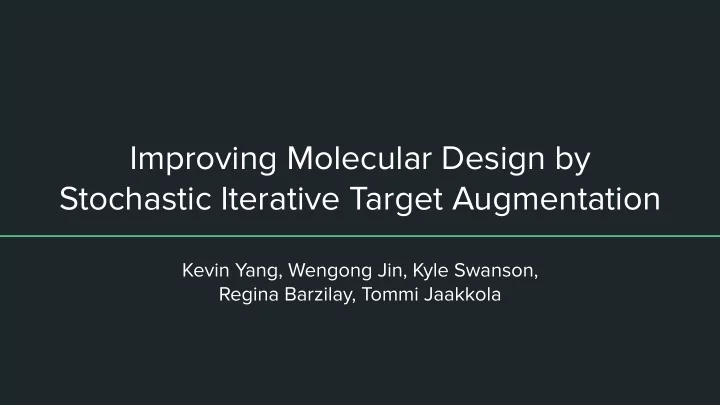

Improving Molecular Design by Stochastic Iterative Target Augmentation Kevin Yang, Wengong Jin, Kyle Swanson, Regina Barzilay, Tommi Jaakkola
15-Second Overview Data augmentation approach: improve molecular optimization SOTA by > 10% Broadly useful for structured generation tasks, e.g. program synthesis (shown later)
Context: Pharmaceutical Drug Discovery Suppose: have promising drug candidate for e.g., COVID-19
Context: Pharmaceutical Drug Discovery Suppose: have promising drug candidate for e.g., COVID-19 Want to make it more potent (higher property score) Have: Want:
Task: Molecular Optimization “Translate” input molecule to a similar molecule with better property score.
Task: Molecular Optimization “Translate” input molecule to a similar molecule with better property score. Dataset: collection of input-target pairs
Why is Molecular Optimization Hard?
Why is Molecular Optimization Hard? Real-world ground truth evaluation: lab assay
Why is Molecular Optimization Hard? Real-world ground truth evaluation: lab assay - Slow + expensive!
Why is Molecular Optimization Hard? Real-world ground truth evaluation: lab assay - Slow + expensive! Key Problem: Small Datasets
Stochastic Iterative Target Augmentation Data augmentation meta-algorithm on top of existing model
Results: Molecular Optimization - Over 10% absolute gain over SOTA on both datasets
Results: Program Synthesis
Stochastic Iterative Target Augmentation Data augmentation meta-algorithm on top of existing model - Sample input-output pairs from generator New “data” Some good , some bad
Stochastic Iterative Target Augmentation Data augmentation meta-algorithm on top of existing model - Sample input-output pairs from generator ? Filtered good “data” only New “data” Some good , some bad How to filter for only the good pairs?
Idea: Filter with Property Predictor Predict
Idea: Filter with Property Predictor This is easier than generation! Predict
Idea: Filter with Property Predictor This is easier than generation! Predict Program synthesis analogue: hard to write program, easier to run test cases
Stochastic Iterative Target Augmentation Data augmentation meta-algorithm on top of existing model - Sample input-output pairs from generator Property - Filter with property predictor, Predictor add good pairs to training data Filtered good “data” only New “data” Some good , some bad
Stochastic Iterative Target Augmentation Data augmentation meta-algorithm on top of existing model - Sample input-output pairs from generator - Filter with property predictor, add good pairs to training data - Train generator, repeat
Outline Setup + Evaluation Detailed Method More Empirical Analysis Program Synthesis Experiments + Results
Outline Setup + Evaluation Detailed Method More Empirical Analysis Program Synthesis Experiments + Results
Real World Molecular Optimization Real-world ground truth evaluation: lab assay - Slow + expensive! ( → small datasets)
Real World Molecular Optimization Real-world ground truth evaluation: lab assay - Slow + expensive! ( → small datasets) - Only use at final test time
Real World Molecular Optimization Real-world ground truth evaluation: lab assay - Slow + expensive! ( → small datasets) - Only use at final test time Use fast + cheap in silico (i.e., computational) predictor for model validation Test time only Can use anytime Data used Lab Assay in silico to train
Evaluation Setup (Lab assay, in silico predictor) become ( in silico predictor, proxy predictor) Test time only Can use anytime Data used Data used Lab Assay in silico Proxy to train to train
Evaluation Setup (Lab assay, in silico predictor) become ( in silico predictor, proxy predictor) Test time only Can use anytime Data used Data used Lab Assay in silico Proxy to train to train - Just train proxy on property values of molecular optimization training pairs
Metric “Success” if even 1/20 tries passes ground truth evaluator
Metric “Success” if even 1/20 tries passes ground truth evaluator Molecular optimization is hard...
Outline Setup + Evaluation Detailed Method More Empirical Analysis Program Synthesis Experiments + Results
Stochastic Iterative Target Augmentation Goal: Somehow Target augmentation: Augment the set of correct targets for a given input.
Stochastic Iterative Target Augmentation 1. Given inputs, sample input-target pairs from current generative model Target augmentation: Augment the set of correct targets for a given input.
Stochastic Iterative Target Augmentation 1. Given inputs, sample input-target pairs from current generative model 2. Filter candidate input-output pairs using property predictor Target augmentation: Augment the set of correct targets for a given input.
Stochastic Iterative Target Augmentation 1. Given inputs, sample input-target pairs from current generative model 2. Filter candidate input-output pairs using property predictor 3. Add good pairs to training data, train model, repeat
Results: Molecular Optimization - Over 10% absolute gain over SOTA on both datasets
Observations - View as Stochastic EM
Observations - View as Stochastic EM - Why iterative? Better generator → easier to find new correct targets
Observations - View as Stochastic EM - Why iterative? Better generator → easier to find new correct targets - May as well use proxy to filter samples at test time too
Outline Setup + Evaluation Detailed Method More Empirical Analysis Program Synthesis Experiments + Results
Frechet Chemnet Distance Analysis FCD (embedding distance) is the molecular analogue to Inception distance in images. Lower is better.
Improved Diversity Diversity: average distance between different correct outputs for the same input
Robustness to Predictor Quality Far left point is oracle (ground truth); second-from left is learned proxy predictor. Blue line indicates baseline performance.
Outline Setup + Evaluation Detailed Method More Empirical Analysis Program Synthesis Experiments + Results
Program Synthesis Task: Karel Dataset Inputs: Test Cases Outputs: Programs Evaluate correctness using held-out test cases
Program Synthesis Target Augmentation
Results: Program Synthesis
Summary Data augmentation meta-algorithm for improving performance on structured generation tasks
Summary Data augmentation meta-algorithm for improving performance on structured generation tasks Significantly improves over SOTA in molecular optimization: > 10%
Summary Data augmentation meta-algorithm for improving performance on structured generation tasks Significantly improves over SOTA in molecular optimization: > 10% Applicable to other domains: program synthesis
Summary Data augmentation meta-algorithm for improving performance on structured generation tasks Significantly improves over SOTA in molecular optimization: > 10% Applicable to other domains: program synthesis Thanks for Watching!
Recommend
More recommend